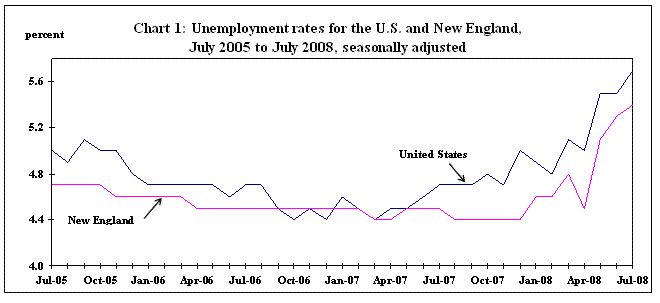Internet address: www.bls.gov/ro1/
For information: (617) 565-2327
Media contact: Walter Marshall (617) 565-2324
USDL-08-244
For release: Friday, August 22, 2008
NEW ENGLAND AND STATE UNEMPLOYMENT: JULY 2008
The New England unemployment rate was essentially unchanged in July at 5.4 percent according to the U.S. Department of Labor's Bureau of Labor Statistics. Regional Commissioner Denis M. McSweeney noted, however, that New England's rate was up 0.9 percentage point over the year. Nationally, the unemployment rate rose to 5.7 percent in July, a full percentage point higher than a year earlier. (See chart 1.)
New England is one of nine geographic divisions nationwide. Among the nine, the East North Central continued to register the highest jobless rate, 7.1 percent in July, followed by the Pacific, at 6.9 percent, and the East South Central, at 6.6 percent. The West South Central again recorded the lowest rate, 4.6 percent, followed by the Mountain, at 4.9 percent. The remaining four divisions, including New England, had rates ranging from 5.2 to 5.8 percent. Seven divisions reported statistically significant over-the-month unemployment rate changes, all increases: the East South Central, South Atlantic, and West North Central (+0.5 percentage point each); East North Central and Pacific (+0.4 point each); West South Central (+0.3 point); and Mountain (+0.2 point). Over the year, eight divisions had significant rate changes, all increases: the East South Central (+1.9 percentage points), Pacific (+1.7 points), South Atlantic (+1.6 points), East North Central (+1.5 points), Mountain (+1.3 points), New England and West North Central (+0.9 point each), and Middle Atlantic (+0.8 point). (See table 2.)
 |
In July, three states in New England posted jobless rates that were significantly different from that of the United States. The jobless rates in New Hampshire and Vermont, at 3.9 and 4.8 percent, respectively, were measurably lower than the 5.7-percent nationwide average. Both were among 22 states in the country to have an unemployment rate significantly below that for the nation in July. In contrast, the unemployment rate in Rhode Island, at 7.7 percent, was measurably higher than that for the United States. Rhode Island was among 12 states and the District of Columbia with unemployment rates significantly higher than the national average. Among the remaining New England states, Massachusetts posted a jobless rate of 5.1 percent in July, Maine, 5.4 percent, and Connecticut, 5.8 percent. These 3 states joined 13 others nationwide having unemployment rates that were not appreciably different from the U.S. average. (See table 1.)
In July, no New England state recorded a statistically significant change in their jobless rate over the month. Over the year, however, each state recorded a measurable change, all increases. Rhode Island reported the largest rate increase in New England and in the nation (+2.7 percentage points), followed by Connecticut (+1.3 points), and Vermont (+1.0 point). These 3 states joined 25 states nationwide and the District of Columbia posting over-the-year rate increases of 1.0 percentage point or more. In the remaining New England states, Massachusetts, Maine, and New Hampshire reported jobless rate advances of 0.7, 0.6, and 0.4 percentage points, respectively. These 3 states were among 15 states nationwide to record smaller, but also statistically significant, rate increases over the year.
Technical Note
This release presents labor force and unemployment data from the Current Population Survey (CPS) and the Local Area Unemployment Statistics (LAUS) program. Estimates for the U.S. are obtained directly from the CPS, which is a sample survey of approximately 60,000 households nationwide that is conducted for the Bureau of Labor Statistics (BLS) by the Census Bureau. The LAUS program produces data for the nine geographic divisions in the United States: New England, Middle Atlantic, South Atlantic, East South Central, West South Central, East North Central, West North Central, Mountain, and Pacific. Data for all divisions, as well as the 50 states, are available in the Regional and State Employment and Unemployment release www.bls.gov/lau/#news issued monthly by BLS, while national statistics are highlighted in the Employment Situation www.bls.gov/cps/#news.
Effective with the release of 2007 annual average estimates on February 29, the historical labor force data for regions, divisions, and states presented in tables 1 and 2 of this news release were revised to incorporate updated population controls, reestimation of models, adjustment to new division and national control totals, and revised seasonal adjustment. Data were revised back to 2003. The updated population controls reflect the annual updating of population estimates by the U.S. Census Bureau.
This information will be made available to sensory impaired individuals upon request. Voice phone: (617) 565-2072, Federal Relay Services: 1-800-877-8339.
Last Modified Date: September 3, 2008

